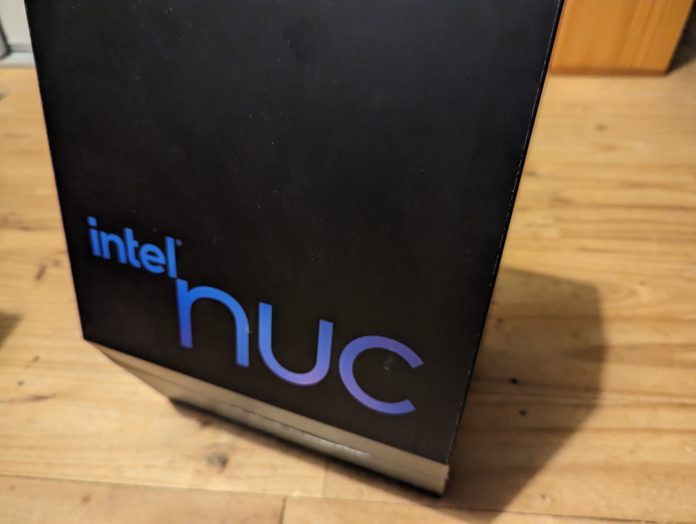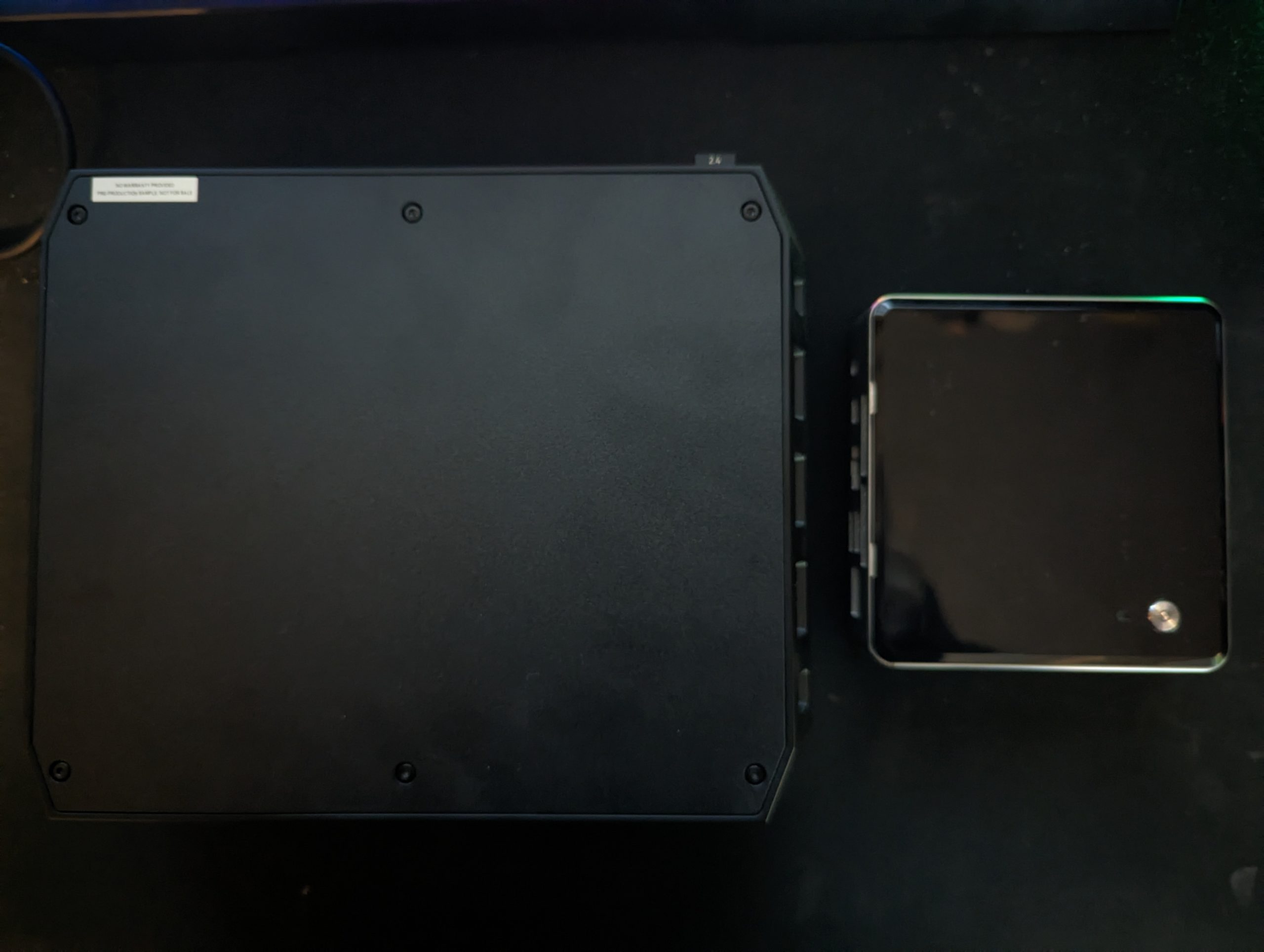Intel NUC units have been around for a number of years now and, slowly but steadily, are becoming more than just a convenient form factor. They’re — when specced up — comparable to most machines on the market.
A few years ago, they moved into the gaming sector and for the last few weeks, I’ve had the NUC Enthusiast 12 on my desk. It’s replaced my ageing desktop machine without skipping a beat and done even more than I expected it to.
What is it?
The simple answer to this is it’s a mini pc. But that’s a very surface value look at the hardware because if you look at what’s inside, what it’s capable of and its physical size, there’s a lot more to it.
If you think about the traditional expectations of a gaming PC, it’s going to be a big box with lots of flare and a price to match. Intel has done much work to knock that standard on the head with the NUC performance devices like the previous generations Hades, and now the Enthusiast series.
The NUC Enthusiast is a relatively small box with a cool backlit serpent (or skull, depending on the specific device) on the side of it. It can be stood upright using the stand, or it can be laid down flat and sit under a monitor stand or in an under-desk shelf to minimise footprint even further. It’s worth noting that the box you buy is a barebone kit, so you’ll need to consider your storage and memory needs.
One thing I’ve struggled with with small form factor PCs in the past is the lack of physical connectivity. This is another area that Intel has addressed with the huge amount of ports available on the NUC Enthusiast device.
On the front of the device are a couple of Thunderbolt ports, a USB 3.0 and a USB 2 port. There’s also, perhaps a bit of a surprise, an SD Card reader slot, the first indicator that this isn’t a one-trick pony and a useful device for gamers and content creators.
On the rear of the machine, you’ve got a seemingly ludicrous amount of ports for the box size. Of course, you’ve got the DC Power input which the comically oversized power pack plugs into, two display ports and an HDMI port for video, Optical/audio output, a Thunderbolt port, a single 2.5GB LAN and four USB3.0 ports. You can easily run multiple 4K monitors with a pile of other accessories hanging off your NUC, ready for anything you care to throw at it.
From a wireless connectivity perspective, you’ve got Bluetooth and Wi-Fi 6. More than enough to meet the needs of most consumers these days. For most of the testing, I’ve been using a Bluetooth headset rather than speakers for audio output.
When it comes to PC hardware, I’ve been a supporter of the theory you should buy hardware that doesn’t just meet your current needs; but the needs you may have for at least two years to come. Or, if that’s not immediately possible, at least get the base-level hardware (motherboard and case) that will allow you to upgrade for the predictable future. My only hesitance with the NUC hardware is the potential lack of future upgradability.
Daily use: It’s nearly silent and never skipped a beat
The small form factor is, of course, one of the attractive features of the NUC Enthusiast. However, it’s also become a little bit of an annoyance for me because to stand it upright, you need a stand to hold it. The provided one feels like it’s about 30% wider than it needs to be, which takes up a bit of space; which goes against the space-saving of the NUC. It’s still a lot smaller than a standard PC box…
I mentioned earlier that this isn’t a one-trick set-up and ran several video renders out of curiosity. With the speed of the storage, plenty of memory and high-end CPU, the NUC enthusiast effortlessly chomped through video rendering quickly and quietly. There were no glitches or unexpected delays.
That aside, I’m a big fan of the design of the NUC Enthusiast. It’s got a bit of flare about it without being completely over the top, with RGB lighting and distractions from what your PC should be doing. Physically, it’s about twice the size of a standard NUC, as you can see.
While I’ve noted the potential lack of upgradability, opening the case and upgrading your RAM or storage is pretty easy. With a couple of screws, open the side and the and the access you need is right in front of you.
Can it game?
Our review unit was a 12th Generation i7-12700H CPU with 16GB of RAM and a 512GB M.2 SSD. So, in reality, it’s not the highest of specs you can have in the current generation of hardware but it’s well put together and it delivers. So to simply answer the question about gaming, it absolutely can!
During testing, I’ve spent some time on several games, including Call of Duty: Vanguard, NBA 2K23 and F1 2022. All of these were handled pretty well, although there were some moments during online play, where there was a few instances of frame drop.
It’s only during heavy gaming that the fan noise was audible, but with speakers going or headphones on; it was barely noticeable.
The downside?
A few issues with the NUC Enthusiast may deter some users; the first and most likely is the price. Don’t get me wrong, I get why it’s expensive with the engineering that’s gone into making this happen, but in the big picture, compared to a similar spec white box, this is an expensive option.
The other thing that blew me away was the earlier mentioned, comically oversized AC adaptor. The thing is about a third the size of the machine itself, so you’ll need somewhere that it can be hidden away, ideally with a bit of ventilation to avoid heat issues. I’d hope, at the cost of high-end NUC hardware and the increasing prevalence of GaN charging, this will be addressed in future models.
Is the NUC Enthusiast something you should buy?
Something that offers this level of performance in a small form factor is still a relatively niche market. So it’s hardly surprising that it’s a fairly high-cost exercise. The review model we had access to retails for $2,199.00 — currently $1,599.00 across a few retailers — with no storage or RAM in it nor supplied operating system. So while it’s a really impressive bit of kit with a lot of performance jammed into a small case, you’ll need a significant budget to set yourself up.
What you get for that budget, though, is impressive!
You get a PC that can handle pretty much anything users — short of hardcore gamers — will throw at it. It’s a really powerful machine, capable of being a reliable workhorse, driving multiple high-resolution monitors and meeting user needs for a good amount of time.
The true advantage, and justifying part of the cost at least, is the physical size of the NUC hardware. It can become a showpiece or, just as easily, be hidden away as a silent and invisible workhorse for your computing needs.
Often review units come and go, but this one has made a really positive impact on me, and I’m disappointed to be packing this up and returning it. When the time comes, I’ll seriously consider a NUC Enthusiast because I’m pretty confident it will meet my needs.

















The “Foot for scale” photo completed the review for me 😉 Genius haha.
Great review as always.
Phil, for cooling the power brick of this NUC, what about using a combo of LEGOs and a cheap fan heater? Most cheap fan heaters, like the Goldair Select 200W Upright Fan Heater at Big W, have a fan only mode. Build a set of supports under the cord ends of the power brick to raise it up into the air stream of the fan. Set the power brick on the supports, so it’s broadside across the air stream, to keep it cool. I know it’s not an elegant solve, like a properly designed power brick, with integral fans, and… Read more »